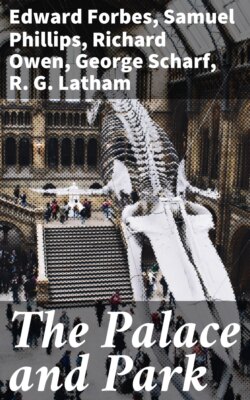Читать книгу The Palace and Park - Edward Winslow Forbes - Страница 44
На сайте Литреса книга снята с продажи.
THE INDIAN COURT.
ОглавлениеPassing on in this gallery, at the back of the Assyrian Court, we enter a department appropriated as an Indian Court. The first object which we notice is a stand covered on both sides with a fine collection of Indian arms and armour arranged with other objects of interest. On the wall near is ranged a collection of most interesting paintings, lent to the Crystal Palace by the Hon. East India Company. They are copies of some frescoes found on the walls of a series of caverns at Adjunta, in Western India, and were made at the instance of the Indian Government by Captain Gill, of the Madras army. The subjects are scenes in the life of Buddha and of Buddhist saints, and various historical events connected with the rise and progress of the Buddhist religion in India. The date of their execution extends from about the Christian era to the tenth or twelfth century; and in style they closely resemble the contemporary works of painters in Europe, possessing nearly the same amount of artistic merit, and displaying the like absence of chiar’-oscuro, and the same attempt to copy with literal exactness the object represented, excepting where certain conventionalities are apparent. The collection is valuable as affording the means of comparing the state of art in the East with that in the West during the same period.
On the next stand are several Burmese idols and other curious objects, mostly belonging to the religious ceremonial of this people; among these will be noticed some very curious wood-carving; and we must not omit to notice in connection with these things, a very peculiar pagoda, or idol shrine, which stands close by. Placed along the floor are some very curious musical instruments, drums or tom-toms of various sizes, some instruments formed of pieces of hard wood, which on being struck sound the notes, and some having metal vessels, which produce a peculiar tone. Further on is a case filled with magnificently embroidered garments, saddle-cloths, &c., which display that craving after splendour which appears to be part of Oriental nature. In this case are also some other choice articles of very great beauty and value, amongst which may be pointed out a small Japanese cabinet; a hookah, a dagger and sheath wrought with silver, a pair of slippers embroidered with pearls, and other rare objects from Persia. Here also are some specimens of Chinese work. On the right of this case is a chamber devoted to Chinese curiosities. The walls are hung with paintings, representing the manufacturing and other industrial occupations of this truly curious people. In the centre is the figure of a Mandarin in his richly embroidered dress. Quitting this chamber the visitor will remark on either side of him some fine models of Indian Mosques, carved in wood, which will amply repay a careful inspection. They belong to the close of the 15th century. After examining the curious model of the encampment of an Indian prince, which now faces him, the visitor will notice a case containing a splendid collection of Javanese arms, some highly wrought with great beauty in gold and silver. This case also contains some wonderful carvings in ivory and pith, as well as other objects of great interest.
